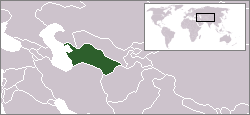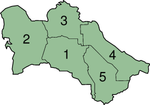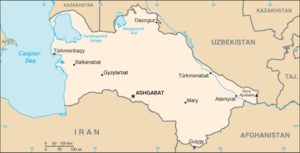Turkmenistan
|
|
| |||||

| |||||
| National anthem | Independent, Neutral, Turkmenistan State Anthem | ||||
| Capital | Ashgabat | ||||
| President and Prime Minister | Saparmurat Niyazov | ||||
| Official language | Turkmen | ||||
| Area – Total – % water | Ranked 51st 488,100 km² Negligible | ||||
| Population – Total (2002) – Density | Ranked 113th 4,603,244 9.4/km² | ||||
| Independence – Declared – Recognised | From Soviet Union October 27, 1991 (Year) | ||||
| Currency | Turkmen manat | ||||
| Time zone | UTC +5 | ||||
| Calling Code | 993 | ||||
| Internet TLD | .tm | ||||
Turkmenistan, once known as the Turkmen Soviet Socialist Republic is a country in Central Asia. It has borders with Afghanistan, Iran, Kazakhstan, Uzbekistan and has a coastline on the Caspian Sea.
| Contents [hide] |
History
Main article: History of Turkmenistan
The territory of Turkmenistan has been populated since ancient times, as armies from one empire to another decamped on their way to more prosperous territories.
Alexander the Great conquered the territory in the 4th century B.C. on his way to India. One hundred fifty years later the Parthian Kingdom established its capital in Nisa, an area now located in the suburbs of the modern-day capital of Ashgabat. In the 7th century A.D. Arabs conquered this region, bringing with them the Islamic religion and incorporating the Turkmen into Middle Eastern culture. It was around this time that the famous Silk Road was established as a major trading route between Asia and Europe.
The Turkmenistan region soon came to be known as the capital of Greater Khorasan when the caliph Al-Ma'mun moved his capital to Merv.
In the middle of the 11th century, the powerful Turks of the Seldjuk Empire concentrated their strength in the territory of Turkmenistan in an attempt to expand into Afghanistan. The empire broke down in the second half of the 12th century, and the Turkmen lost their independence when Genghis Khan took control of the eastern Caspian Sea region on his march west. For the next seven centuries, the Turkmen people lived under various empires and fought constant intertribal wars.
Separated from Persia and annexed by Russia between 1865 and 1885, by 1894 imperial Russia had taken control of Turkmenistan. The October Revolution of 1917 in Russia and subsequent political unrest led to the declaration of the Turkmen Republic as one of the 15 republics of the Soviet Union in 1924. At this time the modern borders of Turkmenistan were formed.
In 1991, with the breakup of the Soviet Union, Turkmenistan achieved independence. It has kept its Communist leader, Saparmurat Niyazov in place.
Politics
Main article: Politics of Turkmenistan
President for Life Saparmurat Niyazov, a former bureaucrat of the Communist Party of the USSR, retains absolute control over the country and opposition is not tolerated. An all-pervasive cult of personality is in place, with President Niyazov as Turkmenbashi ("The Leader of all Turkmens"). His face adorns almost everything in Turkmenistan, from banknotes to bottles of vodka. The logo of turkmen national television is his profile. The two books he had written are mandatory readings in schools, motorclubs, and homes. Institutions that cannot be named after him are named after his mother. All watches and clocks made must bear his portrait printed on the dial-face. His 15 meter (50 feet) tall gold-plated giant statue stands on a rotating pedestral, so it will always face into the sun and shine light onto the capital city, which he himself designed. In reality, Niyazov is a very short person, barely taller than 150 centimeters (5 feet).
A slogan popular among Turkmens is "Halk! Watan! T?bashy!" meaning "People! Motherland! Leader!". Niyazov renamed the week days after members of his family and wrote the new turkmen national anthem-oath himself, including phrases that say people who defamate the motherland or the Turkmenbashi should lose their arms.
Foreign companies seeking Turkmenistan's vast national gas resources have had to cooperate with Niyazov since he also controls access to the natural resources. His "Ruhnama" book has been published by foreign industrialists in all major languages, including Croatian, Polish, Hungarian and Bantu, exactly for this reason.
Provinces
Main article: Provinces of Turkmenistan
Turkmenistan is divided into 5 provinces or welayatlar (singular - welayat):
Geography
Main article: Geography of Turkmenistan
The country is approximately 488,100 square kilometers. 90% of the country is covered by the Karakum Desert. The center of country is dominated by Turan Depression and the Karakum Desert which are mostly flatlands. The Kopetdag Range, along the southwestern border, reaches 2,912 meters. The Balkan Mountains in the far west and the Kugitang Range in the far east are the only other appreciable elevations. Rivers include the Amu Darya and Hari Rud.
The climate is subtropical desert, with little rainfall. Winters are mild and dry, with most precipitation falling between January and May. Heaviest precipitation is in the Kopetdag Range.
Other cities include: Turkmenbashi (formerly Krasnovodsk).
Economy
Main article: Economy of Turkmenistan
One-half of its irrigated land is planted in cotton, making it the world's 10th-largest producer; and it possesses the world's fifth-largest reserves of natural gas as well as substantial oil resources. In 1994, Russia's refusal to export Turkmen gas to hard currency markets and mounting debts of its major customers in the former USSR for gas deliveries contributed to a sharp fall in industrial production and caused the budget to shift from a surplus to a slight deficit.
Turkmenistan has taken a cautious approach to economic reform, hoping to use gas and cotton sales to sustain its inefficient economy. Privatization goals remain limited. Between 1998 and 2002, Turkmenistan has suffered from the continued lack of adequate export routes for natural gas and from obligations on extensive short-term external debt. At the same time, however, the value of total exports has risen sharply because of higher international oil and gas prices. Prospects in the near future are discouraging because of widespread internal poverty, the burden of foreign debt, and the unwillingness of the government to adopt market-oriented reforms.
President Niyazov has squandered much of his country's revenue on self-glorification, with cities, Ashgabat in particular, being given extensive renovations whilst the people living outside the capital struggle in conditions of poverty. President Niyazov has pledged free water, electricity and gas, however, shortages are frequent.
Demographics
Turkmen_man_with_camel.jpg
Main article: Demographics of Turkmenistan
The majority of Turkmenistan's citizens are ethnic Turkmen; other ethnic groups include Russian and Uzbek. Turkmen is the official language of Turkmenistan, though Russian still is widely spoken as a "language of inter-ethnic communication" (per the 1992 Constitution). Education is universal and mandatory through the secondary level, the total duration of which was recently reduced from 11 to 9 years.
Culture
Main article: Culture of Turkmenistan
- Geok-Tepe
- Merv
- Akhal-Teke horse breed
- Carpets
- Music of Turkmenistan
- Holidays in Turkmenistan
- Islam in Turkmenistan
Miscellaneous topics
- Communications in Turkmenistan
- Transportation in Turkmenistan
- Military of Turkmenistan
- Foreign relations of Turkmenistan
- Human rights in Turkmenistan
External links
- Freedom House annual report on freedom (http://www.freedomhouse.org/research/freeworld/2004/countryratings/turkmenistan.htm/) - Freedom House report on Turkmenistan from 2004
- Amnesty Interntional annual report (http://web.amnesty.org/report2004/tkm-summary-eng/) - Amnesty International report on Turkmenistan from 2004
- Cracks in the Marble: Turkmenistan's Failing Dictatorship, International Crisis Group Report from 2003 (http://www.crisisgroup.org/home/index.cfm?id=1445&l=1/) - free registration required for access to whole report
- The Turkmenistan Project (http://www.eurasianet.org/turkmenistan.project/) - weekly news and analysis in English and Russian
- Niyazov's Turkmenistan: a sultanistic regime? (http://www.essex.ac.uk/ecpr/events/jointsessions/paperarchive/grenoble/ws2/cummings.pdf/)- Defining regime in Turkmenistan as sultanistic regime, pdf file
- Photo Gallery from Turkmenistan (http://www.uni-graz.at/franz.koelbl/turkmenistan/) (In German)
| Countries in Central Asia |
|---|
|
China (PRC) | Kazakhstan | Kyrgyzstan | Mongolia | Russia | Tajikistan | Turkmenistan | Uzbekistan |
| Commonwealth of Independent States (CIS) | 
|
| Armenia | Azerbaijan | Belarus | Georgia | Kazakhstan | Kyrgyzstan | Moldova | Russia | Tajikistan | Turkmenistan | Ukraine | Uzbekistan | |



